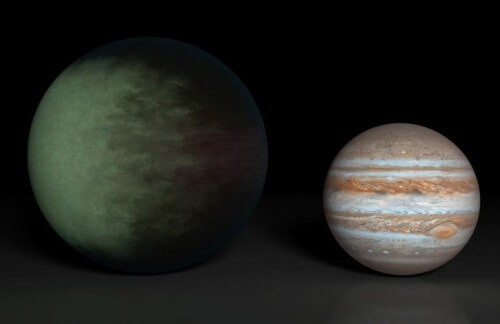Astronomers using data from NASA's Hillel Kepler and Spitzer telescopes have managed to create the first map depicting the clouds on an extrasolar planet, a Jupiter-like planet known as Kepler-7b.

Astronomers using data from NASA's Hillel Kepler and Spitzer telescopes have managed to create the first map depicting the clouds on an extrasolar planet, a Jupiter-like planet known as Kepler-7b.
The planet is characterized by high clouds in the west and clear skies in the east. Previous studies using the Spitzer Space Telescope provided a map of the planet orbiting another sun. This is the first time we can observe cloud structure on a distant world.
"By observing this planet with Spitzer and Kepler for over three years, we can produce a low-resolution 'map' of a gas giant," says Bryce Olivier Demori of MIT. Demori is the lead researcher on the paper published in the Astrophysical Journal Letters. "We cannot expect to see oceans or continents on this type of world, but we were able to detect a bright signature of reflective objects that we interpret as clouds."
Kepler discovered over 150 planets outside the solar system during his activity and Kepler7b was one of the first. The telescope's problematic flywheels prevented it from continuing to hunt for planets, but scientists continue to analyze its massive four-year output of data.
The visible light observations of the phases similar to the lunar shows of Kepler7b - photographed by Kepler himself - made it possible to build a map showing a large spot in the Western Hemisphere coming from clouds or heat. The Spitzer Space Telescope played an important role in answering this question.
Like Kepler, Spitzer can also look in the same direction as the planet orbits its star, creating clues about the planet's atmosphere. Spitzer's ability to detect infrared light means that he was able to measure the temperature of Kepler7b - estimated at 1,100-1,300 degrees Kelvin. This is a relatively cold temperature for a planet whose orbit is so close to its star - 0.06 astronomical units (one astronomical unit means the distance between the Earth and the Sun) and according to astronomers is too cold to be the source of the visible light that Flare saw. Instead, they estimate that the light from the local sun is reflected from the cloud tops located on the western side of the planet.
"Kepler-7b- emits much more light than most of the giant planets we have discovered, which we attribute to the clouds in the upper atmosphere." says Thomas Berkley, a Kepler project scientist at NASA's Ames Space Center in California. "Unlike the clouds on Earth, the cloud patterns on this planet do not appear to change over time. The climate there is extremely stable."
In the future, scientists hope to analyze the atmospheres of planets more similar in size and composition to Earth.
